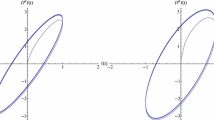Abstract
Hysteresis is a nonlinear phenomenon exhibited by systems stemming from various science and engineering areas. To detect experimentally the presence of hysteresis in a system, its graph output versus input is plotted for different frequencies of the input. For hysteresis systems, these graphs converge to a limit set when frequency goes to zero. Moreover, this limit approaches asymptotically a periodic orbit. The relevance of hysteresis in applications makes it important to characterize it mathematically, which is the purpose of this paper. The systems that are considered are operators that map an input signal and initial condition to an output signal, all belonging to specified sets. The main result of this paper is a criterion for the mathematical characterization of hysteresis. The tools introduced in this paper are illustrated by means of a case study.



Similar content being viewed by others
Notes
\(L^1_{loc}(\mathbb R _+,\mathbb R ^n)\) is the space of locally integrable functions \(\mathbb R _+ \rightarrow \mathbb R ^n\).
That is such that there exist \(t_1,t_2 \in \mathbb R _+\) such that \(u(t_1) \ne u(t_2)\).
A null set is a set with measure zero.
That is \(\Xi =\emptyset \).
If \({\lim \nolimits _{w \downarrow 0}\bar{g}_+(w)=a_+\ne 0}\) and \({\lim \nolimits _{w \uparrow 0}\bar{g}_-(w)=-a_- \ne 0}\), the constants \(a_+\) and \(a_-\) are incorporated into the matrices \(A_+\) and \(A_-\) respectively.
A matrix is Hurwitz if and only if all its eigenvalues have negative real parts.
Note that the initial condition \(\zeta _\infty (0)\) may be different from \(x_0\).
References
Adams RA, Fournier JJF (2003) Sobolev spaces. Elsevier, Amsterdam
Brokate M, Sprekels J (1996) Hysteresis and phase transitions. Springer, New York
Bliman, P-A, Sorine, M (1995) Easy-to-use realistic dry friction models for automatic control. In: Proceedings of the 3rd European control conference, Roma, Italy, pp 3788–3794
Dong R, Tan Y, Chen H, Xie Y (2008) A neural networks based model for rate-dependent hysteresis for piezoceramic actuators. Sens Actuators A 143:370–376
Edgar GA (1990) Measure, topology and fractal geometry. Springer, New York
Enachescu C et al (2006) Rate-dependent light-induced thermal hysteresis of [Fe(PM-BiA)2(NCS)2] spin transition complex. J Appl Phys 99:08J504
Filippov AF (1988) Differential equations with discontinuous righthand sides. Kluwer Academic Publishers, Dordrecht
Fuzi J, Ivanyi A (2001) Features of two rate-dependent hysteresis models. Physica B 306:137–142
Ghost I (2007) Ask the experts. IEEE Control Syst Mag 27(5):16–17
Ikhouane F, Rodellar J (2005) On the hysteretic Bouc–Wen model. Part I: forced limit cycle characterization. Nonlinear Dyn 42(1):63–78
Ikhouane F, Rodellar J (2007) Systems with hysteresis analysis, identification and control using the Bouc–Wen model. Wiley, Chichester
Krasnosel’skii MA, Pokrovskii AV (1989) Systems with hysteresis. Springer, Berlin
Logemann H, Ryan EP, Shvartsmann I (2008) A class of differential-delay systems with hysteresis: asymptotic behaviour of solutions. Nonlinear Anal 69:363–391
Mayergoyz I (2003) Mathematical models of hysteresis. Elsevier Series in Electromagnetism, New York
Macki JW, Nistri P, Zecca P (1993) Mathematical models for hysteresis. SIAM Rev 35(1):94–123
Oh J, Bernstein DS (2005) Semilinear Duhem model for rate-independent and rate-dependent hysteresis. IEEE Trans Autom Control 50(5):631–645
Rudin W (1987) Real and complex analysis, 3rd edn. McGraw-Hill Series in Higher Mathematics, USA
Varberg DE (1965) On absolutely continuous functions. Am Math Mon 72(8):831–841
Visintin A (1994) Differential models of hysteresis. Springer, Berlin
Wiggins S (1990) Introduction to applied nonlinear dynamical systems and chaos. Springer, New York
Acknowledgments
Supported by Grant DPI2011-25822 of the Spanish Ministry of Economy and Competitiveness.
Author information
Authors and Affiliations
Corresponding author
Rights and permissions
About this article
Cite this article
Ikhouane, F. Characterization of hysteresis processes. Math. Control Signals Syst. 25, 291–310 (2013). https://doi.org/10.1007/s00498-012-0099-6
Received:
Accepted:
Published:
Issue Date:
DOI: https://doi.org/10.1007/s00498-012-0099-6



